If you read the last post, you know what’s going on. Here are another ten stories that would definitely be included if I had a chance to put together a giant Batman omnibus collecting personal favorites:
- ‘The Underworld Olympics ‘76!’ (Batman #272-275, cover-dated February-May 1976), by David V. Reed (script), Jose Luis Garcia-Lopez, Ernie Chua (pencils), Ernie Chua, Frank McLaughlin, Tex Blaisdell (inks), Ben Oda (letters)
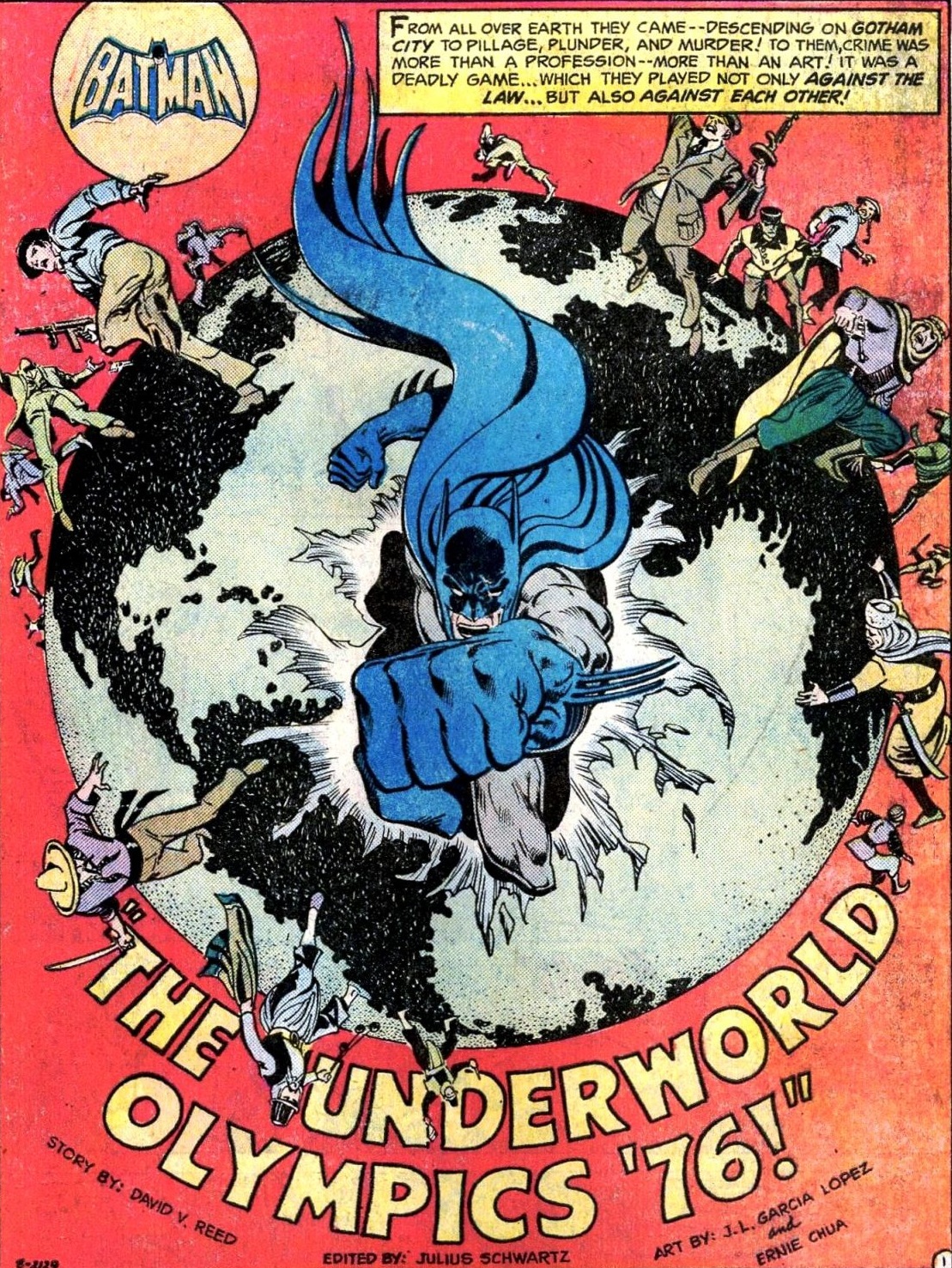
In this underrated 4-part saga, Gotham hosts the International Crime Olympics, a competition between master criminals from across the world. It’s a goofy premise, albeit one with a precedent – back in 1952, Bill Finger and Dick Sprang did a domestic take on this idea (in ‘The Olympic Games of Crime!’). Here, writer David Vern (as David V. Reed) spins an intricate yarn packed with non-stop fights, traps, and puzzles. In each issue, one of the teams – South American, European, Afro-Asian, North American – has to complete a set of challenges while the World’s Greatest Detective tries to deduct what they’re doing. While it’s not original for a Batman adventure to resemble a game, ‘The Underworld Olympics ‘76!’ goes further than most by playing directly with the notion that anything can be a sport if you treat it that way… Some of the ethnic depictions (drawn by Ernie Chan, as Ernie Chua) may not fit too well with current sensibilities, but there is still a lot about these comics that retains my affection. For one thing, they feature one my favorite characters: Gotham City. The city’s geography and culture play a big role in the story, from the Cleopatra’s Needle obelisk to the Gotham Colonial Minute Men Corps, from the Humphrey Bogart Festival to the hyper-organized underworld. I also enjoy the quirky ways in which Reed brings foreign politics into the comic, including a pre-Brexit British crook whose nationalism gets him in trouble with the other Europeans – especially with the Soviet thief, who is all about team work and internationalism! By contrast, the Dark Knight’s Americanness is emphasized through an amusing panel in which he points a finger at a Rhodesian outlaw (who, unlike his countrymen at the time, doesn’t seem to have anything against the black people in his team) and yells ‘Uncle Batman wants you!’ (72 pages)
12. ‘To Kill a Legend’ (Detective Comics #500, cover-dated March 1981), by Alan Brennert (script), Dick Giordano (art), Adrienne Roy (colors), John Costanza (letters)
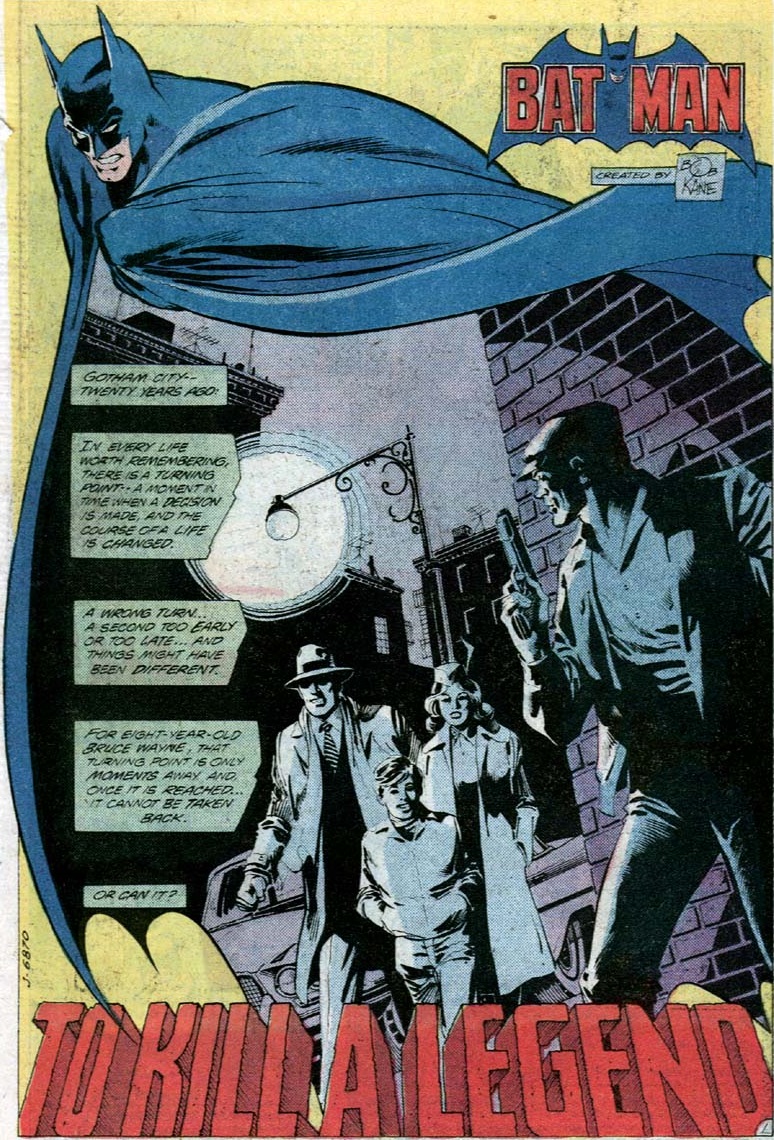 I toyed with the idea of putting this one in the list of essential Batman comics. It’s a minor classic, for sure, but I ultimately decided that it isn’t really ‘essential’ because it didn’t leave much of a mark in the long run (in the sense that later authors haven’t built on it). That said, people *should* read it anyway, because it’s such a brilliant tale. In this companion piece to Bill Finger’s expansions of the background of the Waynes’ murder (in ‘The Origin of the Batman!’ and ‘The First Batman’), the Phantom Stranger sends the Dynamic Duo to a parallel Earth where history is about to repeat itself, giving them the opportunity to prevent this version of Bruce’s parents from being killed. ‘To Kill a Legend’ has a nice time with the notion of Batman and Robin in a world where they regain their primordial oddness, since nobody has ever seen anyone like them (‘if we told you the truth – you’d have us committed instantly!’). The concept goes beyond realism, though. Instead of settling for the boring twist of taking our heroes to a world that’s unfamiliar to them but familiar to us, writer Alan Brennert comes up with a world without heroic mythology at all (‘No Robin Hood – no Camelot – no Hercules, Odysseus, Gilgamesh’), one where crooks faint at the sight of the Caped Crusader! This raises the stakes, as Robin realizes that by preventing Batman’s origin they may be depriving the world of its first hero, which creates an interesting moral dilemma. The way the story solves that dilemma is ingenious and touching, leading to one of the most inspiring endings in the franchise. While it’s not a perfect comic (the premise is somewhat undermined by a panel showing that Sherlock Holmes books do exist in this universe), it confirms Alan Brennert’s incredible knack for powerful characterization (seriously, I could’ve gone with any of his other stories for this slot). (19 pages)
I toyed with the idea of putting this one in the list of essential Batman comics. It’s a minor classic, for sure, but I ultimately decided that it isn’t really ‘essential’ because it didn’t leave much of a mark in the long run (in the sense that later authors haven’t built on it). That said, people *should* read it anyway, because it’s such a brilliant tale. In this companion piece to Bill Finger’s expansions of the background of the Waynes’ murder (in ‘The Origin of the Batman!’ and ‘The First Batman’), the Phantom Stranger sends the Dynamic Duo to a parallel Earth where history is about to repeat itself, giving them the opportunity to prevent this version of Bruce’s parents from being killed. ‘To Kill a Legend’ has a nice time with the notion of Batman and Robin in a world where they regain their primordial oddness, since nobody has ever seen anyone like them (‘if we told you the truth – you’d have us committed instantly!’). The concept goes beyond realism, though. Instead of settling for the boring twist of taking our heroes to a world that’s unfamiliar to them but familiar to us, writer Alan Brennert comes up with a world without heroic mythology at all (‘No Robin Hood – no Camelot – no Hercules, Odysseus, Gilgamesh’), one where crooks faint at the sight of the Caped Crusader! This raises the stakes, as Robin realizes that by preventing Batman’s origin they may be depriving the world of its first hero, which creates an interesting moral dilemma. The way the story solves that dilemma is ingenious and touching, leading to one of the most inspiring endings in the franchise. While it’s not a perfect comic (the premise is somewhat undermined by a panel showing that Sherlock Holmes books do exist in this universe), it confirms Alan Brennert’s incredible knack for powerful characterization (seriously, I could’ve gone with any of his other stories for this slot). (19 pages)
- ‘Smell of Brimstone, Stench of Death!’ (The Brave and the Bold #200, cover-dated July 1983), by Mike W. Barr (script), Dave Gibbons (art), Gary Martin (inks), Adrienne Roy (colors), Dave Gibbons, Gaspar Saladino (letters)
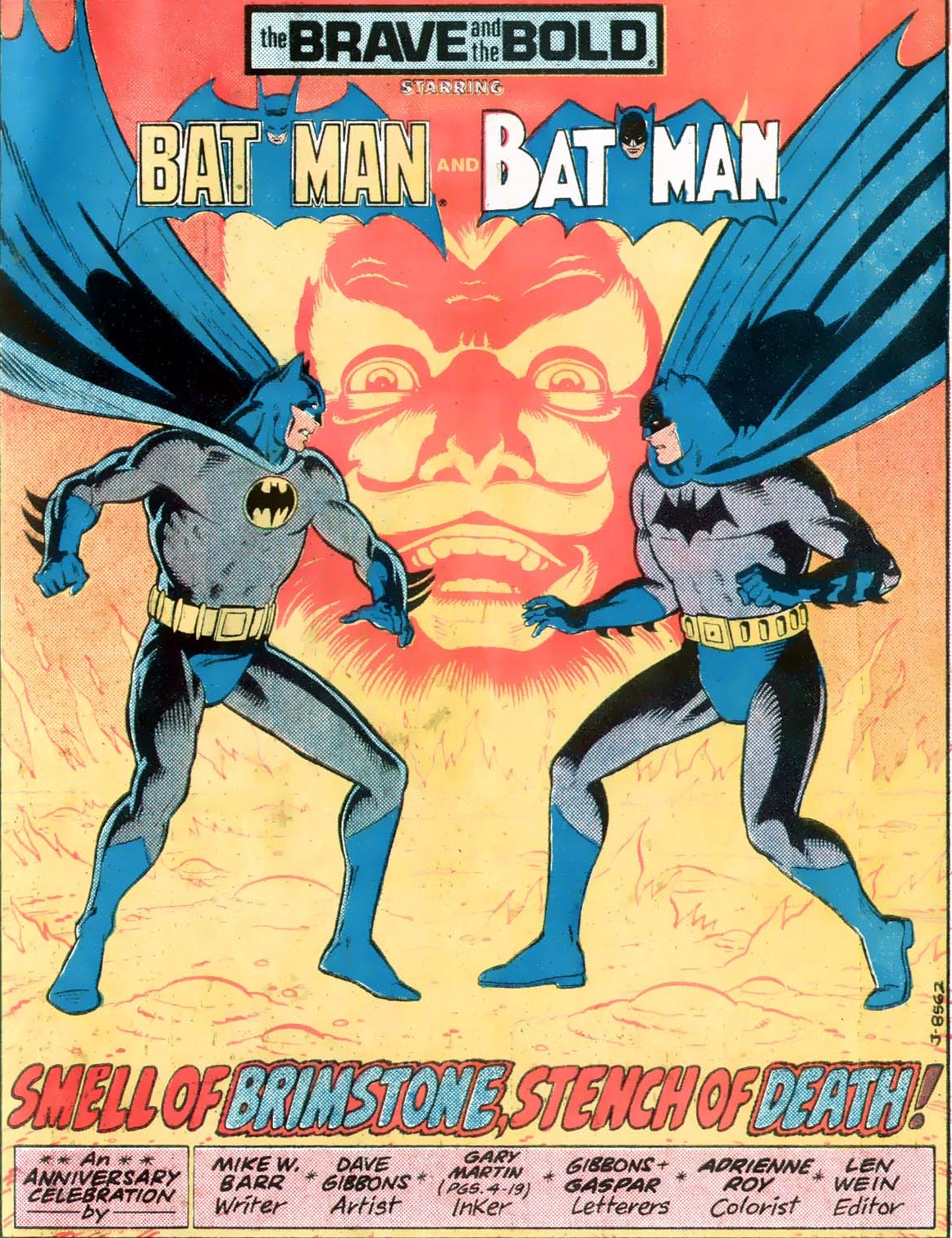 Also taking advantage of DC’s multiverse, Mike W. Barr wrote this super-enjoyable crossover between Batman’s Golden and Bronze Ages. I’ve written about this one before: ‘The first half of the story is set on Earth-2 (where Batman’s earliest adventures took place, in the 1940s and 1950s), pitting the Caped Crusader against a Satan-themed villain called Brimstone. Barr’s writing perfectly captures the tone of a more innocent age, from the playful pun-based clues to Commissioner Gordon’s underwritten role, to the buildings decorated with giant props. Much of the merit goes to artist Dave Gibbons, of course, as well as to Gary Martin, who inked this Earth-2 sequence. Yet what makes the comic awesome is that in the second part of the story Brimstone travels to the current reality (of 1983, when the comic came out), giving Barr the opportunity to tackle the near-apocalyptic feel of that period, in a tale of street gangs, racial riots, and social breakdown. Like the first part, this doesn’t come across as a spoof so much as a straightforward tale written with a different sensibility. Indeed, this section of the issue could have easily belonged to any mainstream comic of the time (including those penned by Barr). By pairing it with the Earth-2 pastiche, though, Mike W. Barr gives us a wonderful viewpoint into the evolution of Batman storytelling. And again Gibbons, who has yet to meet a challenge he cannot match, poignantly illustrates this contrast by delivering some totally ‘80s art.’ (40 pages)
Also taking advantage of DC’s multiverse, Mike W. Barr wrote this super-enjoyable crossover between Batman’s Golden and Bronze Ages. I’ve written about this one before: ‘The first half of the story is set on Earth-2 (where Batman’s earliest adventures took place, in the 1940s and 1950s), pitting the Caped Crusader against a Satan-themed villain called Brimstone. Barr’s writing perfectly captures the tone of a more innocent age, from the playful pun-based clues to Commissioner Gordon’s underwritten role, to the buildings decorated with giant props. Much of the merit goes to artist Dave Gibbons, of course, as well as to Gary Martin, who inked this Earth-2 sequence. Yet what makes the comic awesome is that in the second part of the story Brimstone travels to the current reality (of 1983, when the comic came out), giving Barr the opportunity to tackle the near-apocalyptic feel of that period, in a tale of street gangs, racial riots, and social breakdown. Like the first part, this doesn’t come across as a spoof so much as a straightforward tale written with a different sensibility. Indeed, this section of the issue could have easily belonged to any mainstream comic of the time (including those penned by Barr). By pairing it with the Earth-2 pastiche, though, Mike W. Barr gives us a wonderful viewpoint into the evolution of Batman storytelling. And again Gibbons, who has yet to meet a challenge he cannot match, poignantly illustrates this contrast by delivering some totally ‘80s art.’ (40 pages)
14. ‘…The Player on the Other Side!’ (Batman Special #1, cover-dated April 1984), by Mike. W. Barr (script), Michael Golden (art), Mike DeCarlo (inks), Adrienne Roy (colors), Todd Klein (letters)
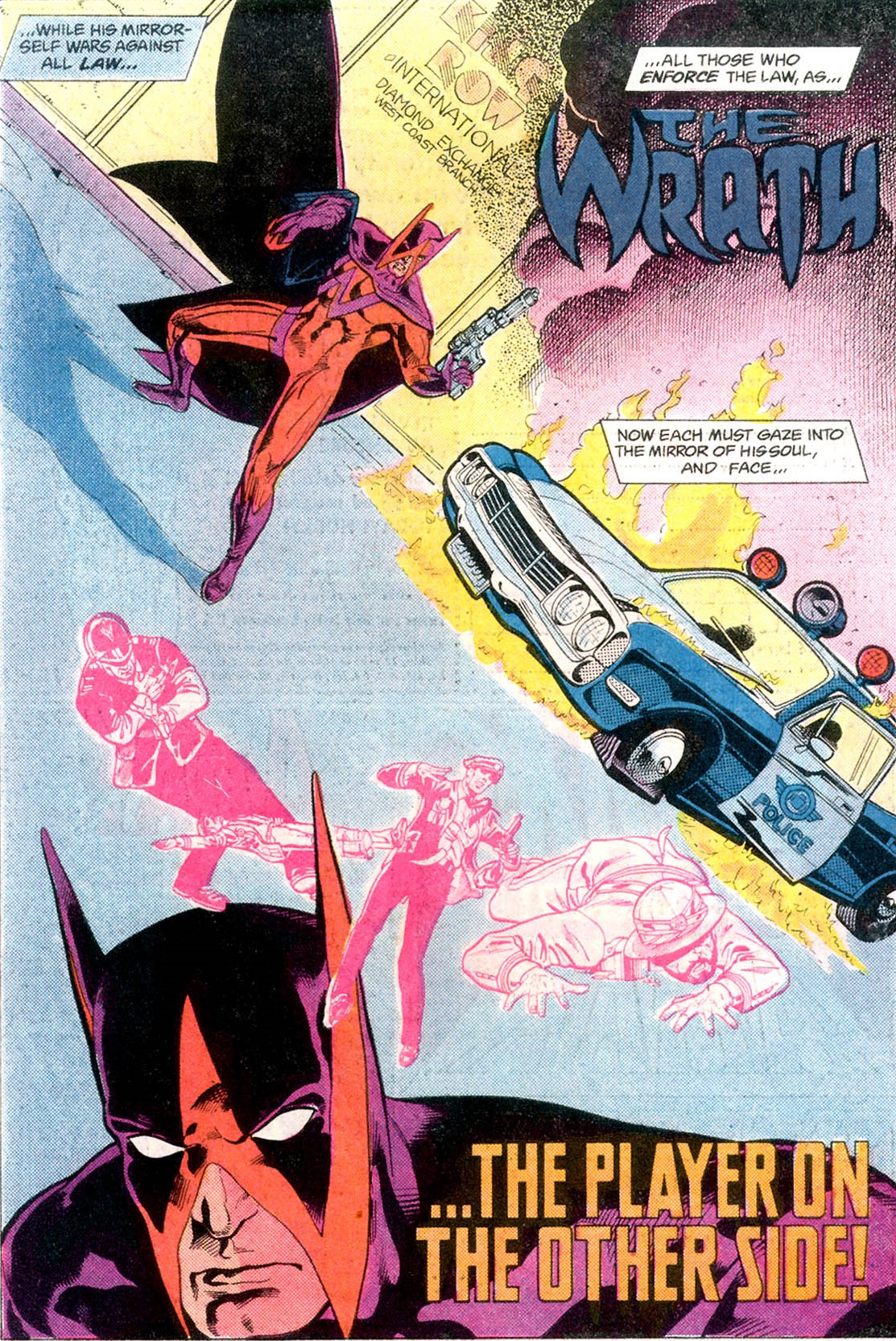 Another minor classic. Barr revisits elements from ‘There is No Hope in Crime Alley!’’ in order to interrogate what makes Batman who is he and what it would look like if he had directed his determination in the opposite direction. The more I reread it, the more I find small moments and ideas I like (even if Barr misses a good opportunity to fully engage with the pertinent question of Batman’s tolerance for murder committed by cops). Again, I wrote about this one here. This is how I described it: ‘It tells the story of a kid who saw his parents killed by the police on the same day that Bruce’s parents were gunned down by Joe Chill and grew up to be an avenging cop-killer known as The Wrath – the symmetrical opposite to Batman. A similar idea has since been used on other villains (including Bane and Prometheus, not to mention a recent reboot of the Wrath himself), but Barr really takes the doppelgänger notion in interesting directions. And so do artists Michael Golden and Mike DeCarlo, who pull off a costume based around the ‘W’ in Wrath that smoothly parallels Batman’s cowl. Drawing on the homonymous works by Aldous Huxley, Manfred B. Lee, and Frederic Dannay (the latter two best known as Ellery Queen), ‘The Player on the Other Side!’ uses the mirror concept to explore what ultimately defines Batman. Notably, the comic illustrates the importance of the supporting cast (Gordon, Alfred, Leslie) in how the Dark Knight eventually turned out.’ (40 pages)
Another minor classic. Barr revisits elements from ‘There is No Hope in Crime Alley!’’ in order to interrogate what makes Batman who is he and what it would look like if he had directed his determination in the opposite direction. The more I reread it, the more I find small moments and ideas I like (even if Barr misses a good opportunity to fully engage with the pertinent question of Batman’s tolerance for murder committed by cops). Again, I wrote about this one here. This is how I described it: ‘It tells the story of a kid who saw his parents killed by the police on the same day that Bruce’s parents were gunned down by Joe Chill and grew up to be an avenging cop-killer known as The Wrath – the symmetrical opposite to Batman. A similar idea has since been used on other villains (including Bane and Prometheus, not to mention a recent reboot of the Wrath himself), but Barr really takes the doppelgänger notion in interesting directions. And so do artists Michael Golden and Mike DeCarlo, who pull off a costume based around the ‘W’ in Wrath that smoothly parallels Batman’s cowl. Drawing on the homonymous works by Aldous Huxley, Manfred B. Lee, and Frederic Dannay (the latter two best known as Ellery Queen), ‘The Player on the Other Side!’ uses the mirror concept to explore what ultimately defines Batman. Notably, the comic illustrates the importance of the supporting cast (Gordon, Alfred, Leslie) in how the Dark Knight eventually turned out.’ (40 pages)
- ‘The Dark Rider/At the Heart of Stone’ (Batman #393-394, cover-dated March-April 1986), Doug Moench (script), Paul Gulacy (art), Adrienne Roy (colors), John Costanza (letters)
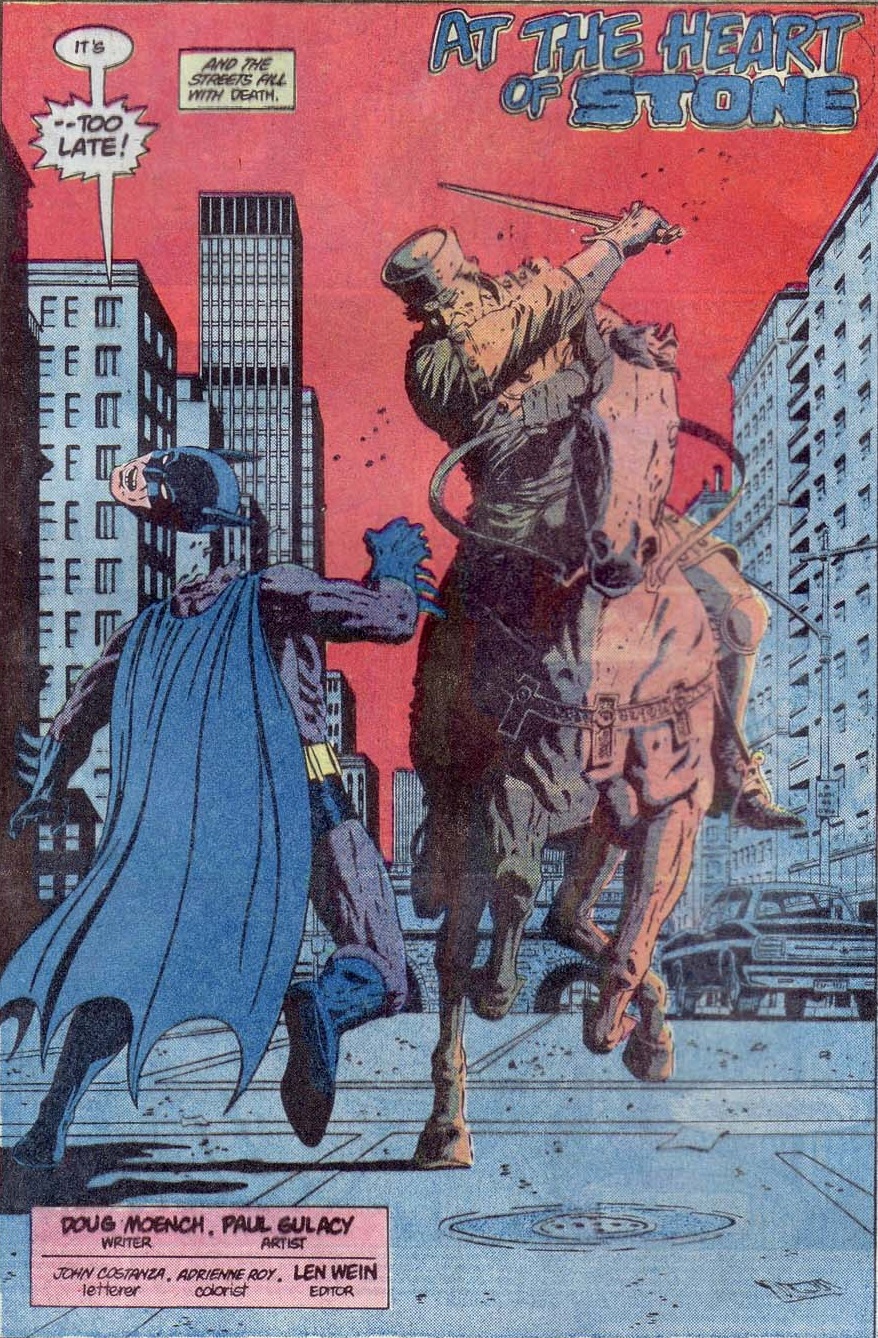 The most Cold War-shaped entry on the list. At a time when film producers desperately struggled to convert the James Bond series into conventional 80s’ action movies (in the passable Never Say Never Again and in the awful License to Kill), Batman starred in a Bond-style two-parter that’s truly worthy of its era’s brand of heart-racing, badass thrillers. It was still done during the golden years of Doug Moench and Paul Gulacy, when the former filled his scripts with subtle subtext and unsubtle wordplay (complaining that they are sitting and waiting while the Dynamic Duo takes care of things, Bullock tells Gordon: ‘I’d offer one of my stogies, Commish, but all’s I got are used butts.’) and the latter’s art hadn’t devolved into mostly rubber-looking cheesecake (Adrienne Roy’s muted colors and the fact that Gulacy inked himself certainly help). I love these comics so much than I will write more about them soon. Meanwhile, this is what I highlighted the first time I brought them up in the blog: ‘As far as I’m concerned, the best use of the Soviet-agent-gone-rogue trope takes place in Batman #393-394, one of the greatest Batman stories of the ‘80s (which is saying something). On the face of it, it’s just more of the same: a renegade KGB operative out of Bulgaria, called the Dark Rider, wants to carry out a terrorist attack against the US, so Batman partners up with a Russian spy, Katia, in order to stop him and prevent war between their nations. This tale fits into the tradition of grand espionage adventures, with the Caped Crusader chasing a plutonium-filled MacGuffin (the pre-revolutionary statue of a Cossack horseman, which comes to represent the Dark Rider himself) through Venice, Bonn, Moscow, and Switzerland, all brought to life by Paul Gulacy’s breathtakingly cinematographic art. The whole thing is packed with neat, little touches… When sieging the Dark Rider in the story’s climax, Katia says ‘We split up here – I’ll go around the back.’ and Robin points out that’s usually the Batman’s line, to which she replies ‘It will take more than a “line” to save this night.’ However, in the end the Dynamic Duo save everyone precisely by wrapping an actual line around the Dark Rider’s feet!’ (46 pages)
The most Cold War-shaped entry on the list. At a time when film producers desperately struggled to convert the James Bond series into conventional 80s’ action movies (in the passable Never Say Never Again and in the awful License to Kill), Batman starred in a Bond-style two-parter that’s truly worthy of its era’s brand of heart-racing, badass thrillers. It was still done during the golden years of Doug Moench and Paul Gulacy, when the former filled his scripts with subtle subtext and unsubtle wordplay (complaining that they are sitting and waiting while the Dynamic Duo takes care of things, Bullock tells Gordon: ‘I’d offer one of my stogies, Commish, but all’s I got are used butts.’) and the latter’s art hadn’t devolved into mostly rubber-looking cheesecake (Adrienne Roy’s muted colors and the fact that Gulacy inked himself certainly help). I love these comics so much than I will write more about them soon. Meanwhile, this is what I highlighted the first time I brought them up in the blog: ‘As far as I’m concerned, the best use of the Soviet-agent-gone-rogue trope takes place in Batman #393-394, one of the greatest Batman stories of the ‘80s (which is saying something). On the face of it, it’s just more of the same: a renegade KGB operative out of Bulgaria, called the Dark Rider, wants to carry out a terrorist attack against the US, so Batman partners up with a Russian spy, Katia, in order to stop him and prevent war between their nations. This tale fits into the tradition of grand espionage adventures, with the Caped Crusader chasing a plutonium-filled MacGuffin (the pre-revolutionary statue of a Cossack horseman, which comes to represent the Dark Rider himself) through Venice, Bonn, Moscow, and Switzerland, all brought to life by Paul Gulacy’s breathtakingly cinematographic art. The whole thing is packed with neat, little touches… When sieging the Dark Rider in the story’s climax, Katia says ‘We split up here – I’ll go around the back.’ and Robin points out that’s usually the Batman’s line, to which she replies ‘It will take more than a “line” to save this night.’ However, in the end the Dynamic Duo save everyone precisely by wrapping an actual line around the Dark Rider’s feet!’ (46 pages)
- ‘Fever/Fever Break!’ (Detective Comics #583-584, cover-dated February-March 1984), by Alan Grant, John Wagner (script), Norm Breyfogle (pencils), Kim DeMulder, Steve Mitchell (inks), Adrienne Roy (colors), Todd Klein (letters)
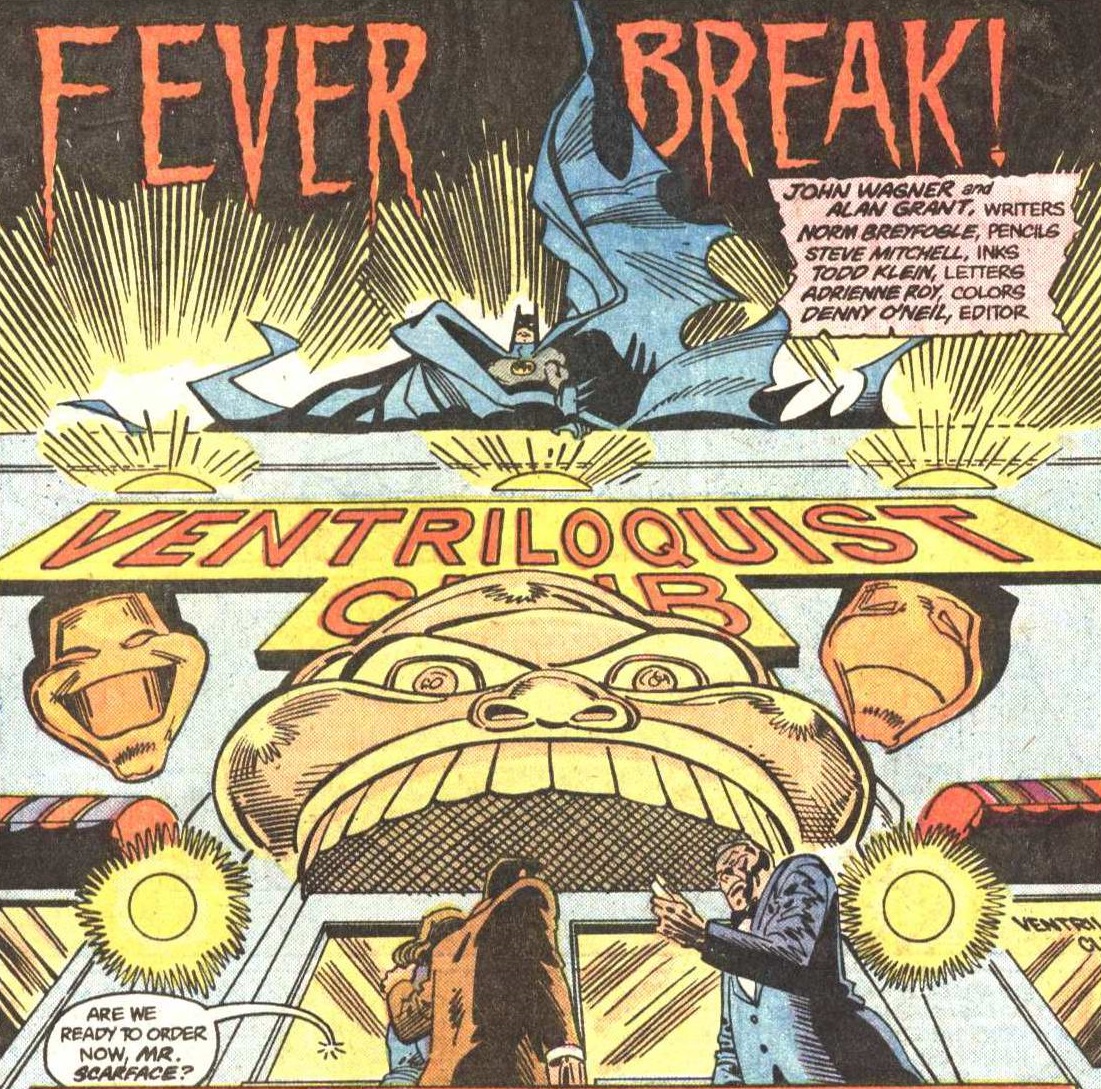
The first story-arc by the awesome duo of Norm Breyfogle and Alan Grant (at this stage still co-writing with John Wagner) hits the ground running, encapsulating the mix of overblown fury, violence, and macabre comedy that characterizes much of their subsequent collaborations. They approach Batman comics as exploitation fiction: the opening pages deliver a pure slice of 1980s’ grit, even before zooming in on a couple of drugged up kids attacking a cat and setting an old man on fire. This sets up a nasty tale about the Dark Knight going after the dealers behind a new designer drug called ‘fever,’ only to end up facing a psycho ventriloquist and his gangster puppet, Scarface (who kind of anticipates Joe Pesci’s terrifying performance in Goodfellas). Along the way, Breyfogle gets to show off by drawing brutal murders, ultra-dynamic action scenes, a trippy climax, and a twisted punchline. Besides his art, what makes this work for me is the overall contrast between downbeat realism, sensationalist hysteria (everyone is on edge in these comics!), and a gleeful flair for the grotesque. Once again, Gotham City comes across as genuinely idiosyncratic – if you think there’s something wrong with our society, just multiply it by a thousand… This helps contextualize Batman as more than a lunatic vigilante tackling recognizable social issues: it shows that Gotham has weird-ass crime and, therefore, a weird-ass crimefighter. (44 pages)
- ‘The Eye of the Beholder’ (Batman Annual #14, cover-dated 1990), by Andrew Helfer (script), Chris Sprouse (pencils), Steve Mitchell (inks), Adrienne Roy (colors), John Costanza (letters)
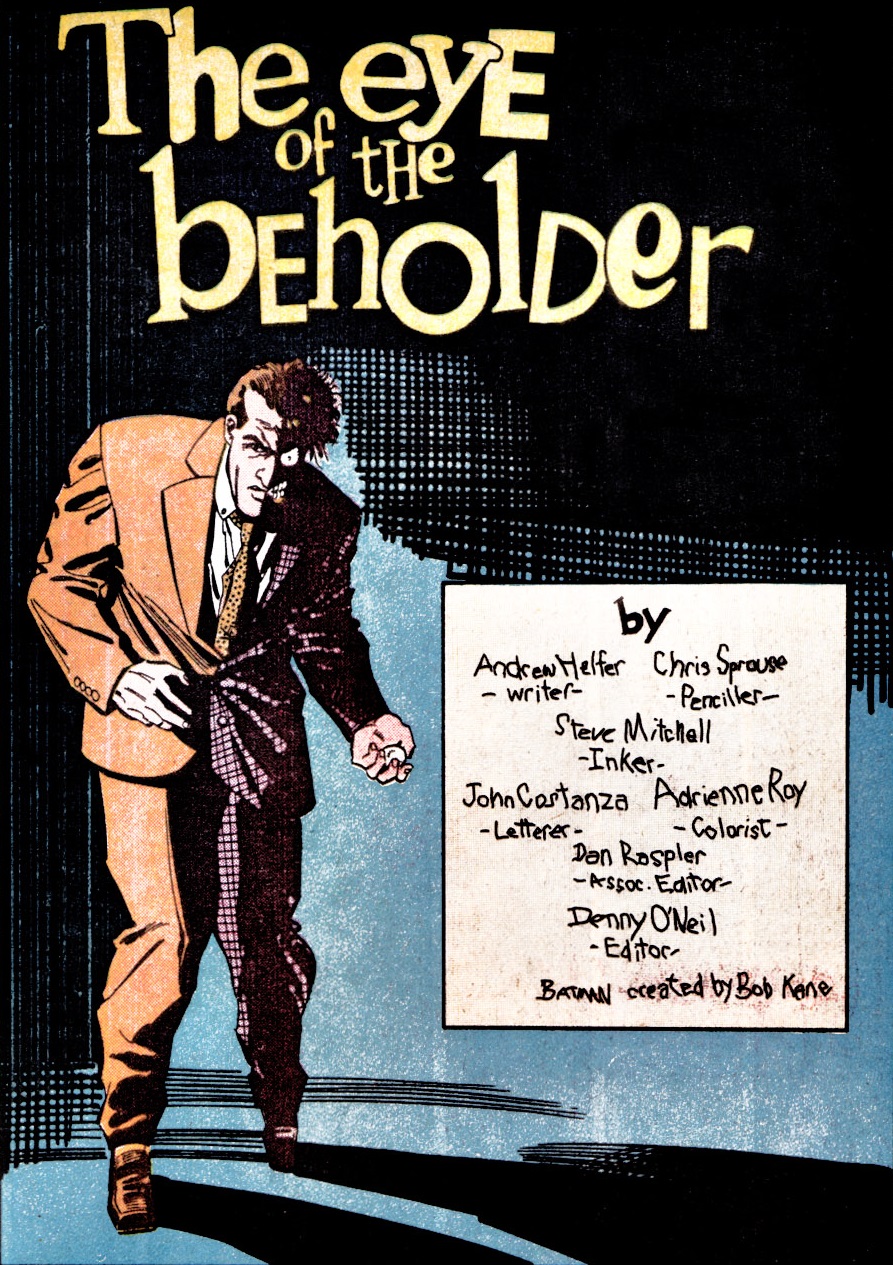 Speaking of grim stories, this deliberately paced reimagining of Two-Face’s origin is not afraid to go into some seriously dark places, including a subplot about child abuse. It’s true – I also like it when Batman comics play it straight every once in a while, especially when they do such a damn fine job of it. Part crime yarn, part psychological drama, ‘The Eye of the Beholder’ is full of strong character moments from the early days of the Dark Knight’s career, like when our hero and then-Captain Jim Gordon discuss the possibility of murdering a serial killer while still trying to figure out how this whole vigilante thing should work. A tale of desperate men in a cruel world, this is a worthy follow-up to the acclaimed Batman: Year One, from which it borrows a mature, hardboiled style. I wouldn’t be surprised if it partly inspired Christopher Nolan’s The Dark Knight. In fact, I honestly can’t understand why it doesn’t show up in fans’ lists more often. It’s that good. (55 pages)
Speaking of grim stories, this deliberately paced reimagining of Two-Face’s origin is not afraid to go into some seriously dark places, including a subplot about child abuse. It’s true – I also like it when Batman comics play it straight every once in a while, especially when they do such a damn fine job of it. Part crime yarn, part psychological drama, ‘The Eye of the Beholder’ is full of strong character moments from the early days of the Dark Knight’s career, like when our hero and then-Captain Jim Gordon discuss the possibility of murdering a serial killer while still trying to figure out how this whole vigilante thing should work. A tale of desperate men in a cruel world, this is a worthy follow-up to the acclaimed Batman: Year One, from which it borrows a mature, hardboiled style. I wouldn’t be surprised if it partly inspired Christopher Nolan’s The Dark Knight. In fact, I honestly can’t understand why it doesn’t show up in fans’ lists more often. It’s that good. (55 pages)
- ‘The Hungry Grass!’ (Detective Comics #629, cover-dated May 1991), by Peter Milligan (script), Jim Aparo (pencils), Steve Leialoha (inks), Adrienne Roy (colors), John Costanza (letters)
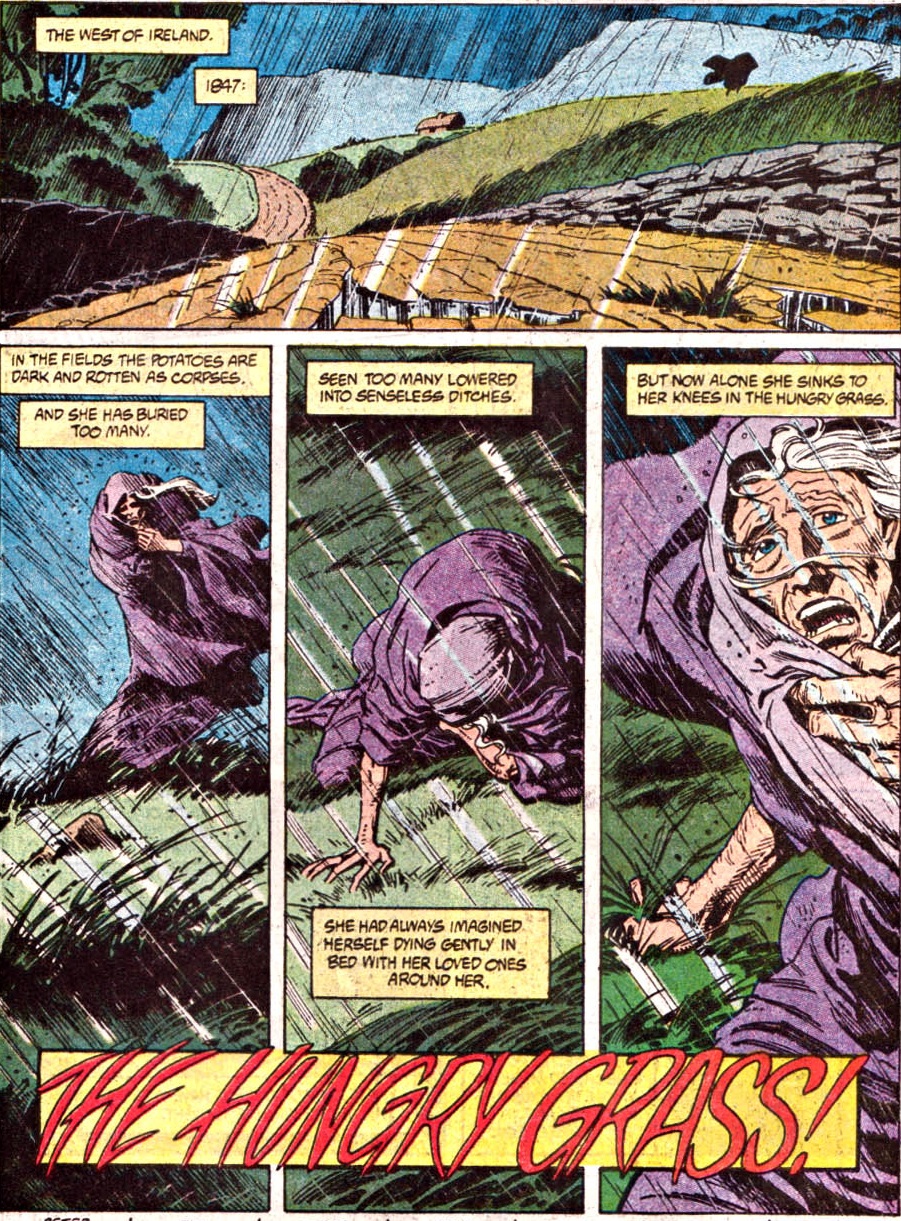
An eerie tale about being literally haunted by the past. The starting point is a tragic villain called Hungry, who uses a magical grass to wreck chaos upon Gotham City, making petty, senseless demands – for example, everyone has to wear a red hat and wash the sidewalk with toothbrushes. From there, the story keeps getting stranger and more convoluted (and, for once, it doesn’t disregard the effects of police brutally). Because the script is by Peter Milligan, it finishes with a touch of existential malaise. As is typical of his collaborations with Jim Aparo, though, ‘The Hungry Grass!’ is not just thoughtful, but also highly entertaining – their partnership exceled at a bizarre type of horror, punctuated with offbeat humor (‘Why can’t he demand money or something that makes sense? This is seriously unamerican, Batman…’), in some ways reminiscent of David Lynch (whose career arc is the subject of a conversation within the comic, at one point). (22 pages)
- ‘Inquiring Minds/Let the Puzzlement Fit the Crime/Malled’ (Detective Comics #647-649, cover-dated August-September 1992), by Chuck Dixon (script), Tom Lyle (pencils), Scott Hanna (inks), Adrienne Roy (colors), John Costanza (letters)
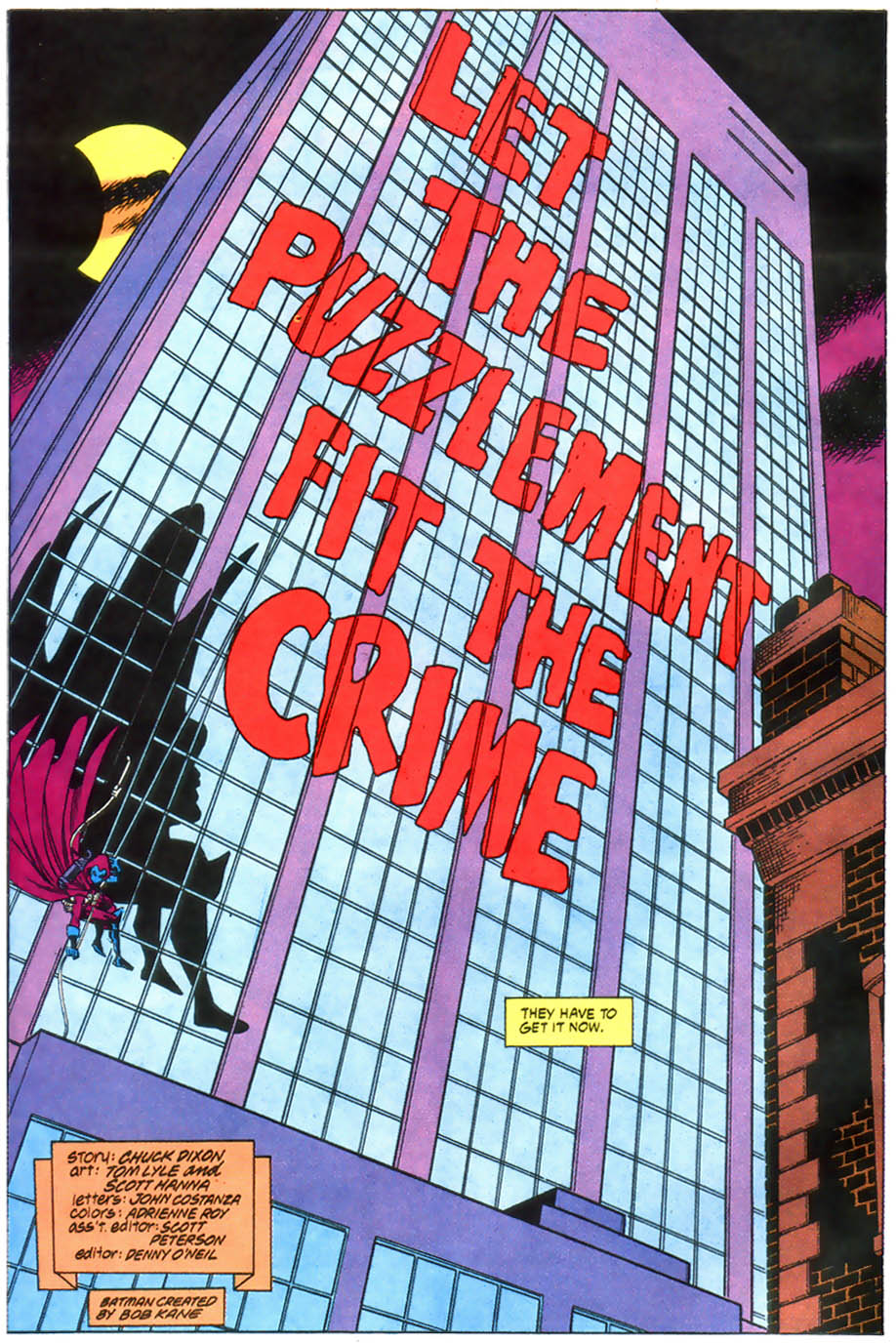
In this witty story arc, the Z-list villain Cluemaster, fresh out of prison, returns to a life of crime and wisely decides to stop sending clues to the police about his future capers (‘You see, I would use my puzzlements as a way of compensating for a lack of self-esteem. I wanted to show my intellectual superiority. But thanks to the wonders of modern psychiatry, all I want now is to be rich.’), yet someone else starts sending clues for him. Pick any issue from Chuck Dixon’s first year in Detective Comics and you are bound to strike gold. His characters behaved as if they were in a smart, mostly grounded crime series, even if some of them wore spandex costumes. The plots typically involved exciting heists, further fleshing out Gotham’s landmarks and city life in the process – in the same way that New York itself became a character in heist movies like the original The Taking of Pelham 123, Dog Day Afternoon, or Inside Man. This three-parter has many of Dixon’s trademarks, including a healthy dose of Gotham politics (it’s set against an upcoming mayoral election, with Commissioner Gordon being used as pawn) and a smooth way of revealing the answers to each clue (a trick Dixon continued to develop in later stories about the Riddler). As a bonus, this also marks the debut of Spoiler, another one of my favorite members of Batman’s supporting cast. (66 pages)
- ‘The Last Riddler Story’ (The Batman Adventures #10, cover-dated July 1993), by Kelley Puckett (script), Mike Parobeck (pencils), Rick Burchett (inks), Rick Taylor (colors), Tim Harkins (letters)
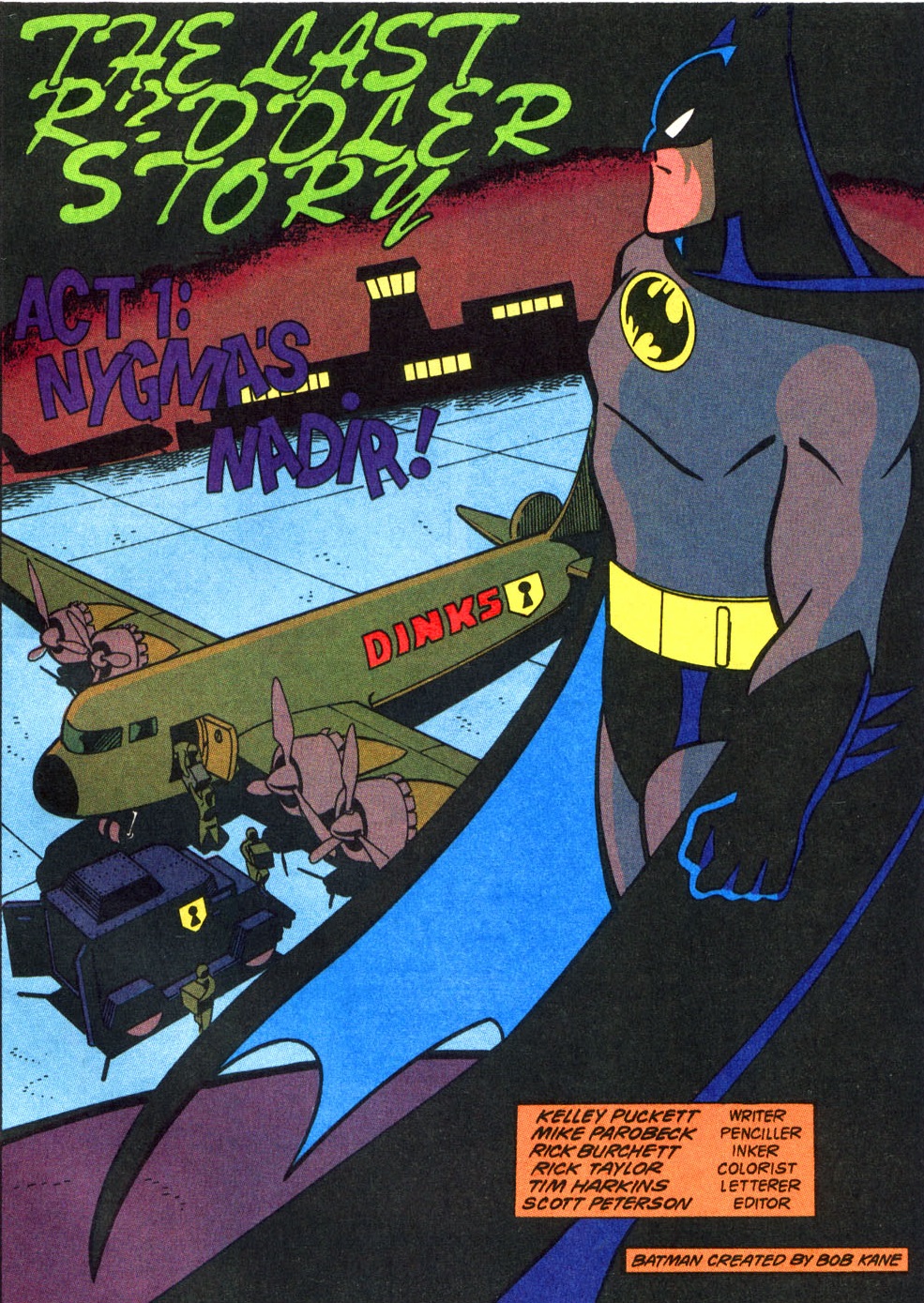
An all-around fun comic, with a cool geeky subtext. I also wrote about this one before: ‘In this laugh-out-loud issue, writer Kelley Puckett and penciller Mike Parobeck (vigorously inked by Rick Burchett) pit the Dark Knight against no less than four hilariously dysfunctional villains. There is Mastermind, whose planning is so meticulous that he even brings his own handcuffs just in case he gets caught, Mr. Nice, who is such a swell guy that he is guilt-tripped into sharing his loot with the people he is robbing, the Perfesser, who is more interested in lecturing pedantically to his accomplice than in completing the actual crimes, and the Riddler himself, for whom actually getting away scot-free is much less important than coming up with a riddle Batman cannot solve. Besides the over-the-top comedy, chock-full of one-liners and sight gags, the issue deserves credit for telling a great Riddler story, one that has a lot of fun with this villain’s eccentric personality. Moreover – as a bonus for comic book geeks – there is a neat metafictional angle, as each of the remaining foes is based on a senior DC editor, namely Mike Carlin, Denny O’Neil, and Archie Goodwin.’ (22 pages)
